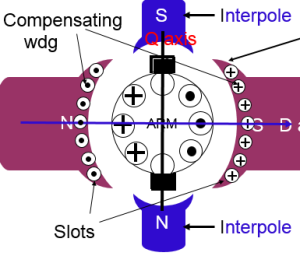Sparking in DC Machines at Brushes
Poor commutation and sparking are caused by distortion of main field flux. The sparking at the brushes results in poor commutation due to the inability of the current in the short-circuited coil to reverse completely by the end of short circuit period (Usually of the order of 1/500). The main reason to delay this quick reversal is due to the production of self-induced e.m.f in the coil undergoing commutation. This self-induced e.m.f in the coil undergoing commutation is known as reactance voltage which is of Small magnitude and produces a large current through the coil whose resistance is less due to short circuit. If this voltage exceeds more than 30 or 40 V, a spark spreads around the commutator in the form of ring fire.

Sparking results in overheating at the commutator. This poor commutation may be caused by the mechanical or electrical condition. The mechanical conditions are uneven commutator surface, non-uniform brush pressure vibration of brushes in the holder. The electrical conditions include an increase in the voltage between the commutator segments an increase in the current density at the trailing edge of the brush etc.
Minimization of Sparking in DC Machines
By using interpoles we can improve the commutation i.e., making the current in the short-circuited coil to attain its full value in the reverse direction by the end of short circuit period.
Interpoles or compoles are small poles fixed to the yoke and are placed in between the main poles. These poles are connected in series with the armature so that they carry full armature current. Their polarity is same as that of the main pole. They induce an e.m.f. in the coil under commutation known as commutating e.m.f or reversing e.m.f (reversal of current).
This reversing emf neutralizes the reactance emf thereby making commutation sparkless.
